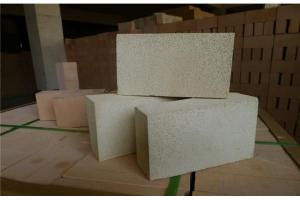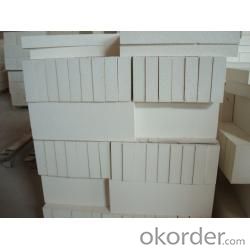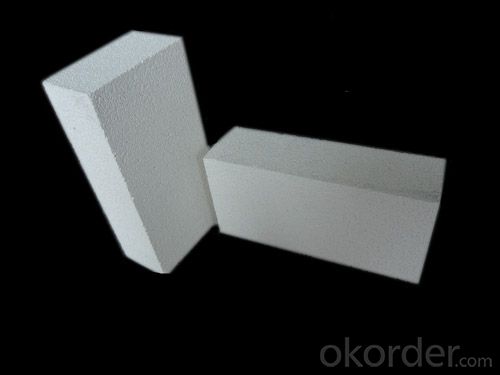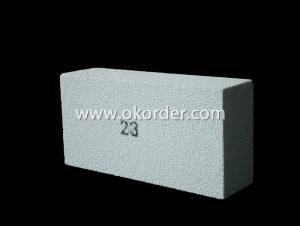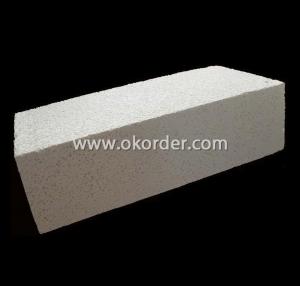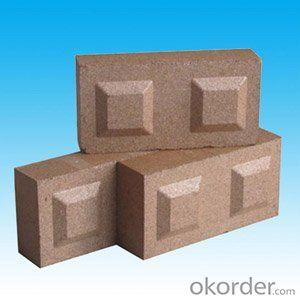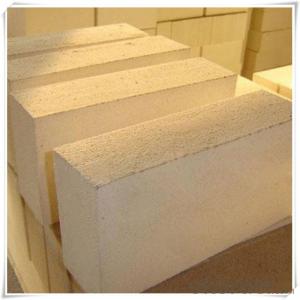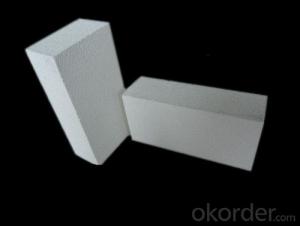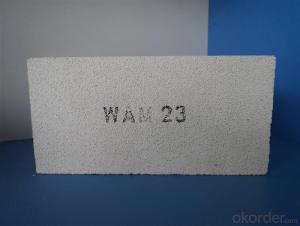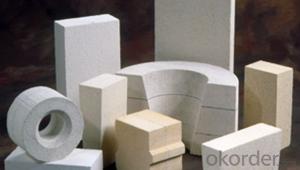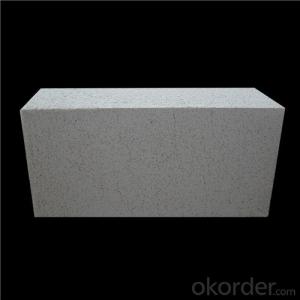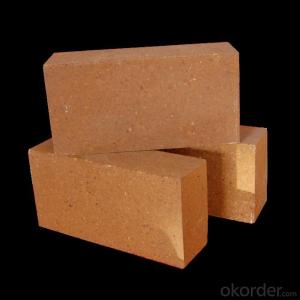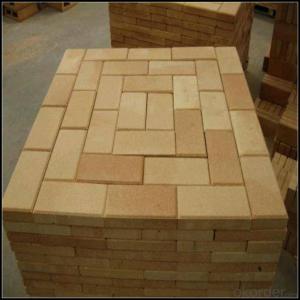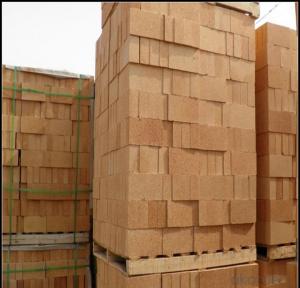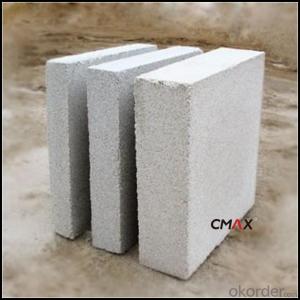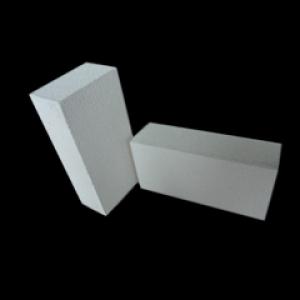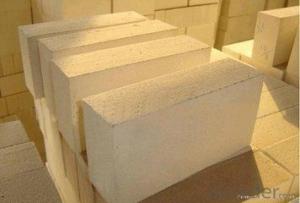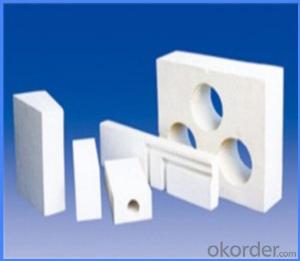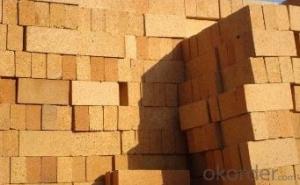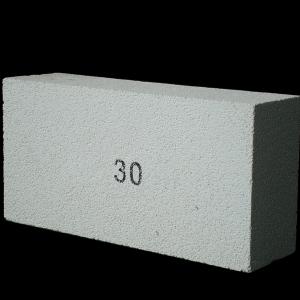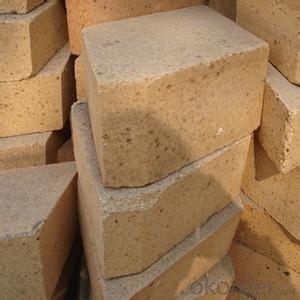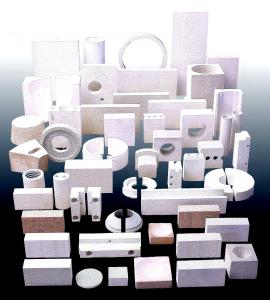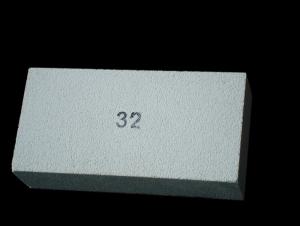Insulating Fire Brick for Fireplace
- Loading Port:
- Tianjin
- Payment Terms:
- TT OR LC
- Min Order Qty:
- 30 m.t.
- Supply Capability:
- 10000 m.t./month
OKorder Service Pledge
OKorder Financial Service
You Might Also Like
CNBM conforms strictly to the requirements of ISO 9000 quality control system during the production. MSDS is also available if you want. The thermal insulation fire clay brick meet with the requirements of ASTM & JIS standards. So pls stay cool with our quality.
Insulating Fire Brick Technical index
Product No. | IFB70 | IFB60 | IFB50 | IFB40 |
Al2O3 | 68%-72% | 58%-62% | 48%-52% | 38%-40% |
Refractoriness (°C ) | ≥1790 | ≥1790 | ≥1790 | ≥1790 |
Bulk density (g/cm3) | 2.50-2.60 | 2.35-2.45 | 2.20-2.30 | 2.10-2.20 |
Apparent porosity (%) | 22 | 19-22 | 17-20 | 17-20 |
Cold Crushing strength (kg) | 480-510 | 450-480 | 430-450 | 390-430 |
Application
Insulating Fire Brick are used for the lining of converter, alternating current arc furnace, direct Current arc furnace and the ladle slag line, etc.
Equipment
1 unit of Ceramic Abrasive (SG Abrasive) pilot production line
2 units of Compact grain Abrasive pilot production lines
1 unit of high-end coated abrasives (abrasive cloth) production line
2 units of Boron Carbide production lines
3 large flexible crushing and sieving lines for grit production lines
2 units of 2000KVA furnaces for Boron Carbide fusion
6 units of 5000KVA-10000KVA dumping type electric arc furnaces for Brown Fused Alumina fusion
Company Advantage
(1)Long Insulating Fire Brick manufacture history: 25 years manufacturer
(2)Advanced equipment
(3)Diversification of production standards: ISO ANSI FEPA JIS ASTM
(4)Flexible payment: T/T L/C D/P D/A
(5)Professional marketing team and after-sale service
(6)Free sample
FAQs
Q1 |
What’s the transport method? |
A1 | FCL delivery goods with wooden pallet or wooden case by sea; If LCL delivery, must with wooden case; Sometimes need open top, flat rack or bulk cargo. |
Q2 |
What’s the required payment term? |
A2 | Generally 30% TT as the prepayment, 70% TT before delivery. If need, 100% Irrevocable Letter of Credit or negotiation. |
Q3 |
Which country are our products exported to? |
A3 | Apart from entire Chinese market, the US, Russia, Japan, Korea, Australia and some Southeast Asian Nations. |
- Q: Are insulating fire bricks easy to cut or shape?
- Insulating fire bricks are relatively easy to cut or shape compared to other types of bricks. This is primarily due to their lower density and composition, which allows them to be more easily manipulated with standard masonry tools. However, it is important to note that the level of ease may vary depending on the specific type and brand of insulating fire brick. Some may require special tools or techniques for cutting or shaping, while others may be more user-friendly. It is always recommended to consult the manufacturer's instructions or seek professional advice when working with insulating fire bricks to ensure proper cutting or shaping techniques are employed.
- Q: What are the dimensions of insulating fire bricks?
- Insulating fire bricks are usually available in different dimensions, which vary depending on the manufacturer and specific usage. However, the most frequently used dimensions for insulating fire bricks are 9 inches by 4.5 inches by 2.5 inches (or 230mm by 114mm by 64mm). These dimensions are widely accepted and commonly employed in the industry. It is worth mentioning that distinct projects might necessitate diverse dimensions, and it is advisable to consult the manufacturer or supplier to determine the most suitable dimensions for your requirements.
- Q: Can insulating fire bricks be used in the construction of radiant tubes?
- Insulating fire bricks are indeed applicable for the construction of radiant tubes. These bricks are specifically crafted to provide exceptional thermal insulation, which makes them extremely suitable for scenarios where heat preservation is crucial. Radiant tubes, on the other hand, are utilized in environments that endure high temperatures, such as furnaces and kilns, where they are exposed to intense heat. By being able to withstand such elevated temperatures, insulating fire bricks aid in minimizing heat loss, thereby leading to enhanced energy efficiency. Moreover, these bricks' insulating properties also serve to safeguard the radiant tubes against thermal shock and extend their lifespan. In summary, incorporating insulating fire bricks into the construction of radiant tubes elevates their overall performance and durability.
- Q: Are insulating fire bricks resistant to thermal stress?
- Yes, insulating fire bricks are designed to be highly resistant to thermal stress. They can withstand high temperatures without cracking or breaking, making them ideal for applications where thermal insulation and durability are required.
- Q: Can insulating fire bricks be used in metal melting furnaces?
- Yes, insulating fire bricks can be used in metal melting furnaces. These bricks are designed to withstand high temperatures and provide excellent thermal insulation, making them suitable for use in metal melting furnaces where heat retention is crucial.
- Q: Can insulating fire bricks be used for insulation in refractory lining repair?
- Indeed, insulation in refractory lining repair can be achieved by utilizing insulating fire bricks. Crafted from lightweight materials, these bricks boast exceptional thermal insulation properties, rendering them perfectly suitable for employment in high-temperature settings like furnaces, kilns, and other refractory lining structures. Their low thermal conductivity and impressive resistance to thermal shock enable them to effectively insulate and safeguard the refractory lining against heat, thereby averting heat loss and diminishing energy consumption. Additionally, the installation and replacement of insulating fire bricks are effortless, solidifying their position as a cost-efficient alternative for refractory lining repair.
- Q: What sizes are insulating fire bricks available in?
- Various sizes of insulating fire bricks are offered to meet different needs and requirements. Sizes typically vary from standard measurements such as 9" x 4.5" x 2.5" to smaller dimensions like 9" x 4.5" x 1". These standard sizes find common usage in fireplaces, kilns, and furnaces. Moreover, industrial applications that necessitate thicker insulation may offer larger sizes. However, it is crucial to acknowledge that the availability of sizes can differ depending on the manufacturer or supplier. Therefore, it is advisable to consult with them to obtain specific size options.
- Q: Can insulating fire bricks be used in ceramic fiber boards?
- Yes, insulating fire bricks can be used in ceramic fiber boards. Insulating fire bricks are commonly used as a lining material for high-temperature applications, as they are able to withstand very high temperatures and provide excellent thermal insulation. Ceramic fiber boards, on the other hand, are lightweight and have good thermal shock resistance, making them suitable for use in various industrial and residential settings. When used together, insulating fire bricks can be placed behind or around the ceramic fiber boards to enhance their insulating properties and increase overall thermal efficiency. The bricks can provide additional structural support and help to retain heat within the system, improving energy efficiency and reducing heat loss. However, it is important to note that the compatibility of insulating fire bricks and ceramic fiber boards may vary depending on the specific application and requirements. It is recommended to consult with manufacturers or industry experts to ensure proper selection and installation of these materials for your specific needs.
- Q: Can insulating fire bricks be used in a refractory lining?
- Yes, insulating fire bricks can be used in a refractory lining. Insulating fire bricks are specifically designed to provide thermal insulation and reduce heat loss in high-temperature applications. They have low thermal conductivity and high insulating properties, making them ideal for use in refractory linings. These bricks can help improve the energy efficiency of furnaces, kilns, and other industrial applications by reducing heat transfer to the surrounding environment. Additionally, insulating fire bricks are lightweight, easy to install, and have good strength and durability, making them a popular choice for refractory linings.
- Q: Outside brick wall, inside brick wall how to return a responsibility?
- Use in indoor environment using brick, not so bad, are generally Youmianzhuan, of course there are all the tiles, bricks, colorful patterns, the appearance of small size error.
Send your message to us
Insulating Fire Brick for Fireplace
- Loading Port:
- Tianjin
- Payment Terms:
- TT OR LC
- Min Order Qty:
- 30 m.t.
- Supply Capability:
- 10000 m.t./month
OKorder Service Pledge
OKorder Financial Service
Similar products
Hot products
Hot Searches
Related keywords
